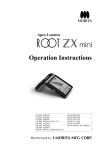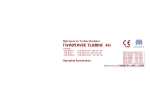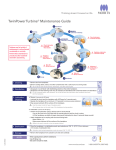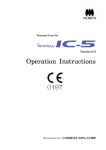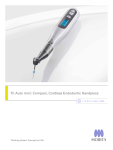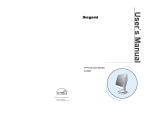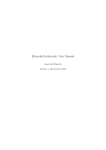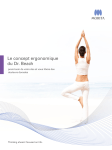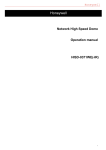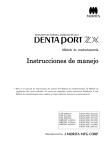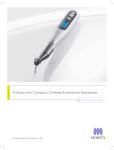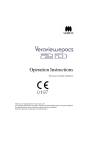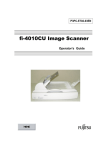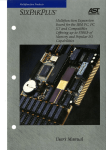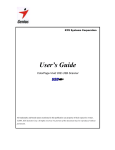Download ifu_tra-200_h5528-e_..
Transcript
Air Motor TRA-200 TRA-200-CP3 TRA-200-CP4 Operation Instructions CONTENTS Introduction ..........................................................................1 Parts Identification and Accessories ...............................10 Operation ............................................................................12 Connect Air Motor..........................................................12 Connect Attachment .......................................................15 Inspectiong and Sterilizing before Use ...........................17 Rotation Direction and Speed .........................................20 Disconnect Attachment...................................................22 Maintenance .......................................................................23 After Use.........................................................................23 Service ............................................................................... 32 Parts Replacement .......................................................... 32 Troubleshooting.............................................................. 40 Technical Information ........................................................ 43 Specifications ................................................................. 43 Terminology and Symbols ............................................. 47 Service and Other Contacts ............................................ 48 Disposal of Medical Devices.......................................... 48 Operation 2009-03-23 Introduction 1 Introduction Thank you for purchasing a AIR TORX handpiece. This instrument is designed for dental treatment such as grinding, drilling and polishing teeth. For optimum safety and performance, read this manual thoroughly before using the unit and pay close attention to the warnings and notes. Keep this manual at hand for ready reference. Caution: Federal law restricts this device to sale by or on the order of a dentist (for U.S.A.). Safety Precautions The instrument must be used in accordance with the instructions in this manual. Read this manual thoroughly prior to operating or maintaining the instrument. Operation 2009-03-23 2 Introduction Note the meaning of these symbols: WARNING : This warns the user of the possibility of extremely serious or irreversible injury or a fatal accident. NOTE Usage Note : This alerts the user to the risk of light to medium injury or equipment damage. This alerts the user of important points concerning operation. The user (i.e., clinic, hospital etc.) is responsible for the management, maintenance and use of medical devices. This instrument must not be used by anyone except legally qualified dentists and oral surgeons / practitioners. This instrument must not be used for any other than the intended purpose as specified in this manual. Operation 2009-03-23 Introduction 3 Disclaimers The J. Morita Mfg. Corp. will not be responsible for accidents, equipment damage, or bodily injury resulting from: 1. repairs made by personnel not authorized by the J. Morita Mfg. Corp. 2. any changes, modifications, or alterations of its products 3. the use of products or equipment made by other manufacturers, except for those procured by the J. Morita Mfg. Corp. 4. maintenance or repairs using parts or components other than those specified by the J. Morita Mfg. Corp. and other than in their original condition 5. operating the equipment in ways other than the operating procedures described in this manual or resulting from the safety precautions and warnings in this manual not being observed 6. workplace conditions and environment or installation conditions which do not conform to those stated in this manual such as improper electrical power supply 7. fires, earthquakes, floods, lightning, natural disasters, or acts of God Operation 2009-03-23 4 Introduction The J. Morita Mfg. Corp. will supply replacement parts and be able to repair the product for a period of 10 years after the manufacture of the product has been discontinued. Warranty is honored only when a claim is accompanied by the warranty agreement with purchase date, product name and model, serial number (inscribed on the body of the product) and name of the distributor. * The user (i.e., clinic, hospital etc.) must perform the inspection procedures specified in the Regular Inspection Check List every three months. * Parts must be replaced periodically as necessary. The Regular Inspection Check List includes a replacement parts list. * Attachments such as the straight handpiece, shank, and contra head have separate user manuals. Do not fail to read these manuals before using the instruments. Operation 2009-03-23 5 Introduction PROHIBITION Electromagnetic wave interference caused by cellular phones, transceivers, remote controls and similar transmission devices could cause the equipment to operate in a random and possibly dangerous manner. All devices which transmit electromagnetic waves near the treatment area should be turned off. Operation 2009-03-23 Introduction 6 Medical Device Safety and Accident Prevention Before using this equipment, carefully read the following: 1. Only fully trained and qualified personnel may operate equipment. 2. Items to be duly noted when installing equipment. 1) Locate the unit in a place where it will not get wet. 2) Install the unit in a location where it will not be damaged by air pressure, temperature, humidity, direct sunlight, dust, salts, or sulfur compounds. 3) The unit should not be subjected to tilting, excessive vibrations, or shocks (including during shipping and handling). 4) Do not install the unit where chemicals are stored or where gas may be released. 3. Items to be duly noted before use. 1) Inspect all switch connections, polarity, dial settings, meters etc. to confirm that the equipment will operate properly. Operation 2009-03-23 Introduction 7 2) Confirm that all cords are connected properly. 3) Take into consideration that simultaneous use of more than one instrument or device can create a dangerous situation or lead to a mistake in diagnosis. 4) Reconfirm the safety of external circuits or systems which are connected directly to the patient. 4. Items to be duly noted during use. 1) Never use the equipment for treatment or diagnosis more than necessary or for longer than necessary. 2) Maintain a constant vigilance for abnormal conditions in both the equipment and the patient. 3) Appropriate steps, such as shutting the equipment down, should be devised to protect the safety of the patient in case any abnormalities in the equipment or the patient are observed. 4) Make sure the patient does not handle or manipulate the equipment. 5. Items to be duly noted after use. 1) Turn the power off after returning dials, switches etc. back to their original positions in the prescribed order. Operation 2009-03-23 Introduction 8 2) Do not use excessive force or pull the cord itself to disconnect cords. 3) The following items should be considered when storing the equipment: (1) The storage area should protect the equipment from getting wet. (2) The storage area should protect the equipment from any possible damage due to atmospheric pressure, temperature, humidity, wind, direct sunlight, dust or air containing salts or sulfur. (3) The equipment should be protected from tilting, vibrations, percussive shocks, etc. (including when it is being moved). (4) The storage are should be free of chemicals and gases. 4) All accessories, cords, etc. should be cleaned, properly arranged. 5) Before storage, the equipment should be cleaned so that it is ready for use again. 6. In case of a malfunction, the operator should attach a written notice indicating that the equipment is out of order without attempting to repair the equipment himself; repairs should be referred to a qualified serviceman. Operation 2009-03-23 Introduction 9 7. Equipment should not be modified in any way. 8. Maintenance and Inspection 1) All equipment and components should be inspected regularly. 2) Equipment which has not been used recently should always be inspected to confirm that it functions properly and safely before being put back into use. Operation 2009-03-23 10 Introduction Parts Identification and Accessories Parts Identification O-rings Frame Speed Adjustment Ring Connection Cylinder Connection Buttons Tube Connector Operation 2009-03-23 11 Introduction Accessories Spray Nozzle (Ethanol disinfectable) AR Spray (Ethanol disinfectable) For TRA-200 For TRA-200-CP3 For TRA-200-CP4 *Standard Accessory *AR Spray Can Accessory *Standard Accessory *Reuse the nozzle when you replace the AR spray can. Operation 2009-03-23 12 Operation Operation Connect Air Motor WARNING • After connecting the motor, give it a light tug to make sure it is securely connected; otherwise, air pressure might force it off the tube and result in an injury. • Before connecting CP-3 and CP-4 models, check the lamp cover and o-ring on the tube. Make sure that the lamp cover is securely tightend up and that the o-ring is not pushed back out of place; otherwise, air pressure might force the instrument off its tube and result in an injury. Operation 2009-03-23 Operation 13 Usage Note • Handle the motor carefully. Do not drop it or bang it. This could impair its performance. • Make sure the motor’s connection end and the o-rings on the main tube are clean and free of dust and debris. Otherwise, the handpiece could malfunction. Operation 2009-03-23 14 Operation [TRA-200] [TRA-200-CP3] [TRA-200-CP4] Tube Ring Ring Line up the pipes on the motor with the holes in the tube connector, and put the motor on the tube. Tighten up the tube ring. Hold the ring on the tube and push the handpiece in until there is an audible click. Hold the tube and slide the handpiece over until it clicks securely into place. Operation 2009-03-23 15 Operation Connect Attachment WARNING • Before use, check the motor and attachment carefully; give the attachment a light tug to make sure it is securely connected. Otherwise, it might come off and injure the patient. • Never put an attachment on or take one off while the air motor is actually running. • For CP-3 and CP-4 models, the attachment could stick out of its holder somewhat depending on the treatment unit. This creates a risk of accidental injury. NOTE • Do not change the rotation direction while the motor is actually running. Operation 2009-03-23 Operation 16 Simple put the straight handpiece or shank attachment on the motor until it clicks into place. The attachment is free turning. Usage Note • Attachments with lights cannot be used. • If attachments are hard to put on and take off, apply a little AR Spray to the o-rings on the connection cylinder. Operation 2009-03-23 Operation 17 Inspectiong and Sterilizing before Use The air motor is not autoclaved before shipping. Do not fail to autoclave the motor before using it. Initial Inspection 1. Make sure that no parts are loose and that the motor is not scratched or damaged. 2. Make sure the motor is securely connected to its tube. 3. Make sure that the cutting tool for the attachment is securely installed. Operation 2009-03-23 Operation 18 4. Run the motor only at maximum speed without a load and check the following points. * Do this with the spray turned off. ■ Runs smoothly and without any unusual noise. ■ Cooling air is coming out of the connection cylinder. 5. Run the motor only at maximum speed at maximum speed. Connect an attachment and repeat the above test. * Do this with the spray turned off. See if it feels hot. NOTE Operation without cooling air can cause the attachment to heat up and result in a burn. Operation 2009-03-23 19 Operation 6. Connect an attachment, run the motor at maximum speed without a load and check the following points. ■ Make sure the attachment is securely connected ■ Runs smoothly and without any unusual noise. A fine, misty spray is emitted. ■ There is not air or water leakage from the connection joints. Operation 2009-03-23 Operation 20 Rotation Direction and Speed WARNING • Before actual use, always operate the handpiece outside the oral cavity to make sure it runs smoothly in the right direction and at the right speed and that the burr does not wobble. Otherwise, the patient could be injured. • Never touch the connection buttons while the Air Torx is actually running; this could cause it to come off and injure the patient. • Wait for the instrument to stop rotating before taking it out of the patient’s oral cavity; otherwise it could injure the patient. • For CP-3 and CP-4 models, take the attachment off when the air motor is not being used. Leaving it on creates a risk of accidental injury. Operation 2009-03-23 21 Operation NOTE Follow burr maker’s recommendation rotation speed and direction. Max. Turn the Speed Adjustment ring to set the speed and rotation direction. Speed Adjustment Ring Forward Usage Note 0 • Do not rotate the straight handpiece with its chuck open. Reverse Max. Operation 2009-03-23 Operation 22 Disconnect Attachment Press both connections buttons down all the way and then pull the attachment off the motor. Connection Buttons Operation 2009-03-23 23 Maintenance Maintenance After Use <Disconnect> [TRA-200] Take the motor off its tube. [TRA-200-CP3] [TRA-200-CP4] Ring Coupling Hold the ring on the tube and pull the handpiece straight off. Pull the coupling slightly towards the tube and then pull the handpiece off. Operation 2009-03-23 24 Maintenance <Cleaning> Use the brush and running water to clean the air motor. <Disinfection> Use a piece of clean gauze and brush to disinfect the whole surface of air motor with Ethanol for Disinfection (Ethanol 80 vol%). Usage Note • Do not use anything other than ethanol. • Do not use too much ethanol: it could seep inside and damage the motor. • Do not wipe the o-rings on the connection cylinder with ethanol. This will remove their lubricant and result in damaging them. Eventually this will lead to air and water leakage. • Do not let debris get in the lines. This will cause poor rotation and spray delivery. Operation 2009-03-23 25 Maintenance <Lubrication> [TRA-200] Clean and lubricate the motor with AR Spray once a day or before autoclaving. Take the motor off its tube. Set the speed adjustment ring on the forward (F) side. Insert the AR Spray nozzle into the drive air line, cover the exhaust line with a piece of gauze, and spray for 2 or 3 seconds. Spray Nozzle Air Exhaust (Spray exhaust) Spray Nozzle For TRA-200 Drive Air (Spray in here) Operation 2009-03-23 26 Maintenance [TRA-200-CP3, TRA-200-CP4] Clean and lubricate the motor with AR Spray once a day or before autoclaving. Take the motor off its tube. Set the speed adjustment ring on the forward (F) side. Attach the spray nozzle to the spray can. Insert the nozzle into the handpiece connection end and spray for 2 or 3 seconds. Spray Nozzle For TRA-200-CP3 For TRA-200-CP4 Operation 2009-03-23 Maintenance 27 WARNING • Do not point the spray nozzle at anyone and do not use the spray near an open flame. • For the TRA-200, spray will come out of the exhaust line; cover it with gauze before spraying. If spray accidentally gets into your eyes, wash them out with plenty of water and see a doctor. Use soap and water to wash off any spray on your skin. Usage Note • • • • • The motor will malfunction without regular AR Spray maintenance. Always use the AR Spray can in an upright position. Shake the AR Spray can 2 or 3 times before using it. The motor cannot be lubricated if the speed adjustment ring is set on zero. Do not use any spray nozzle other than the one designed for the Air Torx motor. Operation 2009-03-23 28 Maintenance <Connect> Connect motor to tube. <Operate> Run the motor for about 15 seconds to eliminate excess spray. Operation 2009-03-23 Maintenance 29 <Disconnect> Take the motor off its tube. <Packaging> Wipe the motor with a piece of gauze dampened with Ethanol for Disinfection (Ethanol 80 vol%) and put it in a sterilization pouch. Operation 2009-03-23 30 Maintenance <Sterilization> Recommended temperature and time: minimum of 5 minutes at 132° C in a sterilization pouch. Minimum drying time after sterilization: 10 minutes. WARNING To prevent the spread of serious, life-threatening infections such as HIV and hepatitis B, the motor must be autoclaved after the treatment of each patient. NOTE Instruments are extremely hot after autoclaving; do not touch them until they cool off. Operation 2009-03-23 Maintenance 31 NOTE • • • • Do not sterilize in any way except autoclave. The handpiece could be damaged if it is not properly cleaned and lubricated before autoclaving. Autoclave and drying temperatures must not exceed 135° C. High autoclave temperatures can damage the o-rings etc. Put the motor in a sterilization pouch to keep it from directly contacting heat sources or the inside of the autoclave. • Do not leave the motor in the autoclave over night. • Never wipe the motor with corrosive solutions such as electrolytic acid, strong alkaline solutions or other commonly available cleaning solutions. • Do not autoclave the motor with an attachment connected. Operation 2009-03-23 32 Service Service Parts Replacement ■ Replace the parts listed in the Regular Inspection List (separate document) as necessary depending on degree of wear and length of use. ■ Order replacement parts from your local dealer or the J. Morita Corp. O-ring Set One-way Valve (TRA-200 only) Gasket (TRA-200 only) Operation 2009-03-23 Service 33 <O-ring Replacement> Connection Cylinder The o-rings eventually wear out resulting in air or water leakage or both. Replace all three o-rings at the same time. WARNING O-rings Do not fail to take the old o-rings off. Leaving them on could cause the motor to come off its tube and this could injure the patient. Operation 2009-03-23 Service 34 <One-way Valve Replacement (TRA-200 only)> * If the one-way valve for the spray is defective, contamination could get in the water lines. Inspect this valve once a month. Gasket Spray Pipe Usage Note Pull Returns: OK Stops: No Good Inspect the One-way Valve for the Spray Use a disposable, plastic syringe with no needle. Slide the end of the syringe over the spray pipe and press it flush up against the gasket. Pull the plunger out slightly and see if it goes back towards the motor by itself because of the partial vacuum created. If it doesn’t move back at all, the one-way valve is defective and needs to be replaced. • The motor will malfunction without regular AR Spray maintenance. • Make sure the syringe fits tightly against the gasket without any gap whatsoever; otherwise, a vacuum will not be created inside the syringe, and the plunger will not be pulled back even if the one-way valve is in good condition and working properly. Operation 2009-03-23 Service 35 Replacement Spray One-way Valve * Use a needle or something to take the gasket off. Then take the one-way valve out and replace it with a new one. Put the gasket back in its original position. Usage Note Gasket • The fat part of the spray pipe has a critical role in making a good seal; do not scratch or damage it. Operation 2009-03-23 Service 36 Storage Ambient Storage conditions Temperature -10 ~ 70 ºC Humidity 10 ~ 85 % RH (without condensation) Atmospheric pressure 700 ~ 1,060 hPa * No frequent or continuous exposure to direct sunlight. * If the motor will not be used for awhile, first autoclave it and then store it in a clean, dry place. * The safe and effective working life of the motor is 7 years after manufacture provided it is properly inspected and maintained. Operation 2009-03-23 Service 37 Inspection Regular Inspection * Use the Inspection Check List provided to inspect the instrument every 3 months. * It is assumed that the user will perform regular maintenance and inspection procedures. However, if necessary or desired, these may be performed by a trained professional qualified to repair medical devices. Contact your local dealer or the J. Morita Office. Operation 2009-03-23 38 Service Regular Inspection Check List Item Attachment Connection Procedure Check that attachment can be securely connected to motor. Operate the motor and make sure air pressure does not cause the attachment tocome off. Repeat 3 times. Air Motor Overheating Run the motor without an attachment or load at maximum speed for 3 minutes. Then see if it feels too hot. Do the same thing with an attachment connected. Motor Rotation Direction Control Make sure the motor changes rotation direction properly. Switch from forward to reverse rotation three times. Operation 2009-03-23 39 Service Item Procedure Run the motor at maximum speed by itself without a load and check the following. 1. Runs smoothly without unusual noise. 2. Cooling air is emitted from the connection cylinder. Air Motor Rotation and Spray Connect an attachment, run the motor at maximum speed and check the following. 1. Runs smoothly without unusual noise. Fine misty spray is emitted. 2. No air or water leakage at the motor’s joints. 3. Light works (if equipped with a light) Operation 2009-03-23 40 Service Repairs * For repairs, contact your local dealer or the J. Morita Corp. Troubleshooting Use the check list below if the motor does not seem to be working properly. * Contact your local dealer or the J. Morita Corp., if the apparatus does not work normally even after inspection, adjustment or parts replacement, or if the dentist cannot perform maintenance procedures himself. * Before inspection and adjustment, check to see if the main switch is on and if the main water and air valves are open. Operation 2009-03-23 41 Service Burr does not rotate ( Make sure the speed adjustment ring is not on “0.”) Take the attachment off the motor. Step on the pedal and see if the motor runs Doesn’t run Lubricate with AR Spray. Reconnect and make sure connection is securely tightened up. Doesn’t run Runs OK. Runs OK. Reconnect attachment and see if it works. Doesn’t work Have attachment inspected and repaired See if air comes out of the main tube. Yes Have Air Torx inspected and repaired No Have main tube and chair inspected and repaired. Operation 2009-03-23 42 Service No spray from attachment Take the attachment off the motor. Step on the pedal and see if water comes out. No Disconnect motor. Step on the pedal and see if water comes out of the main tube. No Yes Yes Inspect connection cylinder o-rings. Defective o-rings: Replace all 3 o-rings. (Coat o-rings with a little AR Spray.) O-rings are OK: Clean out the air and water nozzles on the attachment. (Refer to user’s manual for attachment.) Still no water Have main tube and chair inspected and repaired. Have Air Torx motor inspected and repaired. Have Attachment inspected and repaired. Operation 2009-03-23 Technical Information 43 Technical Information Specifications Model Type AIR TORX TRA-200 / TRA-200-CP3 / TRA-200-CP4 Operation 2009-03-23 44 Technical Information Air Pressure Range Recommended Air Pressure Range Water Pressure Range Tip Air Pressure Exhaust Pressures Maximum Rotation Speed (At 0.25MPa) Usage Speed Range (At 0.25MPa) Stop Torque (At 0.25MPa) Air Flow (At 0.25MPa) 0.2-0.3 MPa 0.25 MPa 0.05-0.2 MPa*with attachment 0.2-0.3 MPa *with attachment Recommended: 0.07 MPa, max. *0.25 MPa (at output end) 20,000 ± 2,000 rpm 5,000-20,000 rpm 3.5 N・cm 46 NL/min Operation 2009-03-23 45 Technical Information Type Dimension Weight (Approx.) Motor Length (Approx.) Outer Diameter (Approx.) Handpiece Coupling Tube Connector TRA-200 TRA-200-CP3 TRA-200-CP4 75 g 70 mm φ20 mm 85 g 85 g 80 mm 85 mm φ20 mm φ20 mm ISO3964: 1982 (only for attachments without lights) ISO9168: 1991/ *SFSO-1, SFS-1, CP3-O *CP4, CP4-O, CP4-WO, CP5-O EN29168: 1994 Type C * "SFSO-1,SFS-1" is Morita original connection tubing. * "CP3-O" is Morita original coupling. * "CP4, CP4-O, CP-WO, CP5-O" is Morita original coupling. Operation 2009-03-23 46 Technical Information * Ambient conditions for use Temperature: 10~40° C. Relative Humidity: 30~75 R% (without condensation). Atmospheric pressure: 700~1,060 hPa. NOTE Excessive air pressure could impair the instrument’s performance. It could also result in an injury. Usage Note • Drive air should be clean and dry. [Specifications may be changed without notice due to improvements.] Operation 2009-03-23 47 Technical Information Terminology and Symbols CE (0197) marking Model Conforms to European medical device Directive 93 / 42 / EEC. Operation Instructions Manufacturer Type Serial Number Autoclavable up to 135° C The first character of the serial number specifies the year of manufacture as follows: Authorized representative in the European Community X: 2009 Y: 2010 Z: 2011 Operation 2009-03-23 Technical Information 48 Service and Other Contacts For repair or other types of service contact your local dealer or the J. Morita Office. Disposal of Medical Devices Any medical devices which could possibly be contaminated must be first decontaminated by the responsible doctor or medical institution and then be disposed of by an agent licensed and qualified to handle medical and industrial waste. Operation 2009-03-23 EU Authorized Representative under the European Directive 93/42/EEC MEDICAL TECHNOLOGY PROMEDT CONSULTING GMBH Altenhofstraße 80, 66386 St. Ingbert, Germany TEL: +49-6894-581020 FAX: +49-6894-581021 The authority granted to the authorized representative, MEDICAL TECHNOLOGY PROMEDT Consulting GmbH, by J. Morita Mfg. Corp. is solely limited to the work of the authorized representative with the requirements of the European Directive 93/42/EEC for product registration and incident report. J. MORITA MFG. CORP. 680 Higashihama Minami-cho, Fushimi-ku, Kyoto, 612-8533 Japan www.jmorita-mfg.com Distributors J. MORITA CORPORATION Tokyo Office : 11-15, 2-Chome Ueno, Taito-ku, Tokyo, 110-8513 Japan Osaka Office : 33-18, 3-Chome Tarumi-cho, Suita, Osaka, 564-8650 Japan J. MORITA USA, Inc. 9 Mason, lrvine, CA 92618 U.S.A.. TEL:+1-949-581-9600, FAX: +1-949-465-1095 J. MORITA EUROPE GMBH Justus-Von-Liebig-Strasse 27A, D-63128 Dietzenbach Germany TEL: +49-6074-836-0, FAX: +49-6074-836-299 SIAMDENT CO., LTD. 444 Olympia Thai Tower, 3rd Floor, Ratchadapisek Road, Samsennok, Huay Kwang, Bangkok 10310, Thailand TEL: +66-2-512-6049, FAX: +66-2-512-6099 J. MORITA CORPORATION Australia and New Zealand Suite 2.05, Aero 247 Coward Street Mascot NSW 2020, Australia TEL: +61-2-9667-3555, FAX: +61-2-9667-3577 PUB. H5528-E Printed in Japan




















































